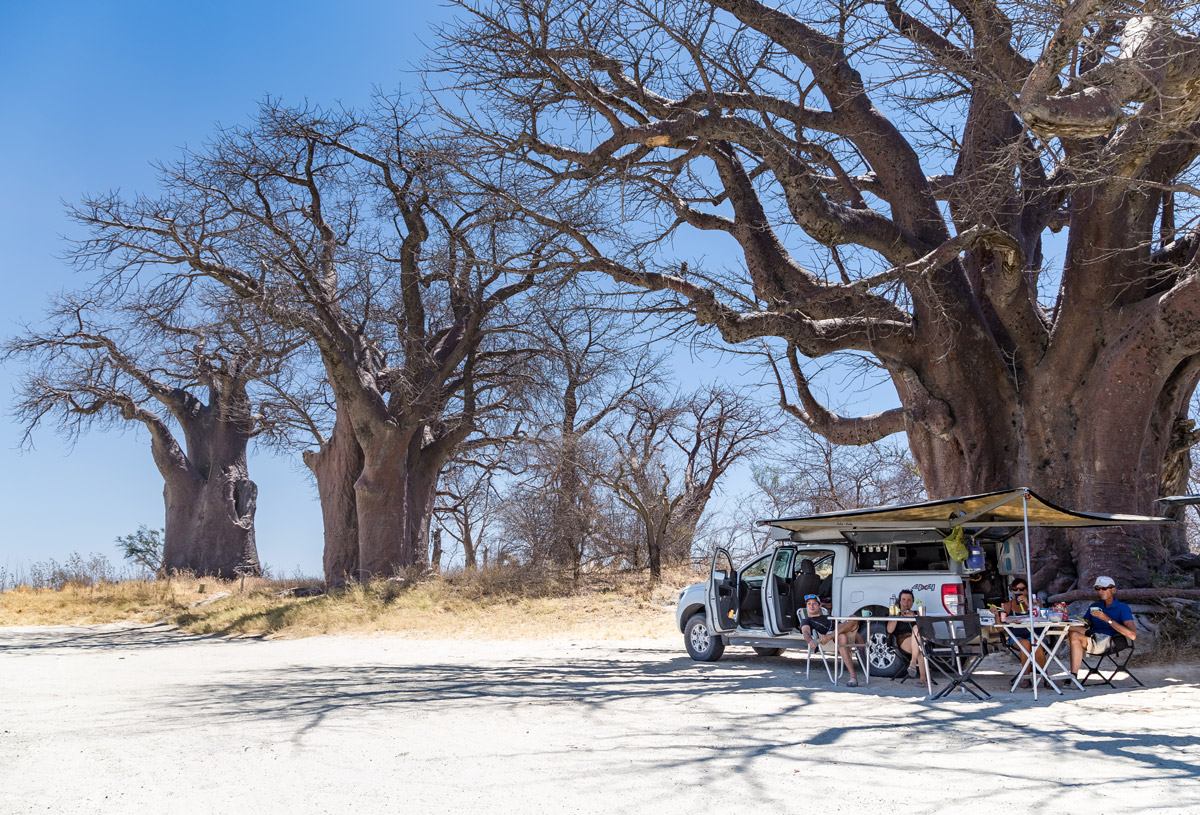Botswana is packed with fantastic campsites, but few are more inspiring than Baines’ Baobabs in Nxai Pan National Park. By Chris Davies
In 1861, an expedition left South Africa to explore the Zambezi River from Victoria Falls into present day Namibia. The two principal explorers were Thomas Baines, an English artist and adventurer, and James Chapman, a South African trader and photographer. Their goal was to determine whether the Zambezi was navigable to the ocean, but various setbacks hampered the project and a full picture of the area was never achieved.
Shop: Latest Namibia and Botswana Self-Drive Guide Books
Although a failure at the time, the accounts both explorers left of their travels, through written journals, paintings and – unique for the period – photographs, make for a fascinating legacy. One such artefact is a small watercolour painting by Thomas Baines, showing a cluster of enormous baobabs against a purple sunset sky. The watercolour is the first European depiction of what are now known as Baines’ Baobabs, and the impressive huddle of trees still stand, seemingly unchanged since they were first painted 155 years ago.
Nowadays, Baines’ Baobabs fall inside Botswana’s Nxai Pan National Park, about an hour’s sandy drive from the park’s only entrance gate near Gweta. Camping at the trees themselves is not permitted, but three beautiful, private campsites nearby allow easy access, and have baobabs of their own, which provide shade and more than a touch of splendour.
The campsites are unfenced and exclusive, and are spaced a couple of kilometres apart around the local Kudiakam Pan. Each has its own pit toilet and rig for a shower, but there’s no water or other facilities of any kind. That’s not unusual for Botswana, a country packed full of wonderful, isolated campsites, but there’s something about these massive trees that makes camping at Baines’ Baobabs particularly special. It is thought that baobabs can live to be well over 1,000 years old, perhaps even twice that, and these have certainly stood unchanged since Thomas Baines first saw them. It’s a humbling thought, one made even more humbling under the star-filled Southern African sky.
Campsite 1 is closest to the main stand of trees (about 750m) and has excellent views of them across the pan. This also makes it the least private – in as much as privacy is a problem: you’re unlikely to see more than half a dozen cars in a day. Farthest away, campsite 3 is certainly the most private, with thick scrub surrounding the stand and obscuring the view of the nearby pan. Both 1 and 3 have towering baobabs at their centre, but campsite 2 beats them both with two huge trees, and great views on all sides.
In winter, when the pans are dry, there is very little game in the immediate area. Further north, the permanent water at Nxai Pan itself makes the park’s alternative public campsite, South Camp, an especially good spot for elephants. These often wander around and through the campsite on their way to drink, sometimes taking on the ablutions and camp water tower (and winning) in search of fresh water.
In summer, the rains allow animals to forage and hunt widely across the region, but they also turn the tracks along the pans to mud and convoy driving is essential. Winter is certainly the more accessible season. If it’s game you’re after, then a night at South Camp is definitely recommended, but for pure Botswana bliss, don’t miss a detour to Baines’ Baobabs and spend a few nights contemplating the hundreds of years that have passed while these ancient trees sent their roots into the earth and stretched their thick trunks to the sky.
T4A travel tips
- Nxai Pan National Park has only one gate, on the A3, 65km west of Gweta.
- There’s a petrol station at Gweta, but not always fuel.
- Nxai Pan gate times: winter 06:00-18:30, summer 05:30-19:00.
- You must have a paid-up campsite booking (with Xomae Group) before entering the park.
- There is borehole water and cellphone reception at the gate, but no water or reception at Baines’ Baobabs. Water is available at South Camp.
- Access to the park is strictly 4×4 only. There is thick sand starting 10km north of the gate and continuing to the Baines’ Baobabs turnoff, and most of the way to South Camp. In summer, the pans and surrounding areas flood and the thick mud can be impassable.
- Travelling in convoy is recommended.
Prices & booking info
Camping must be booked and paid for first, then pay park entrance fees to the Botswana Department of Wildlife and National Parks (DWNP). DWNP payment can be made in advance or at the gate on the day, provided you have a valid campsite booking. Credit card facilities have recently been introduced at the gate, but they can be unreliable so best to take cash.
Xomae Group operates Baines’ Baobabs (and South Camp)
Camping per day for SADC residents:
- Adults: USD30
- Kids (8-17 years): USD15
- Kids (0-7 years): Free
Max 12 people and 3 vehicles per stand.
Contact: +267 686 2221, xomaesites@btcmail.co.bw, www.xomaesites.com
The Botswana Department of Wildlife and National Parks
Fees per day for SADC residents:
- Adults: P120
- Kids (8-17 years): P60
- Kids (0-7 years): Free
- Per vehicle: P50
DWNP central reservations: +267 318 0774, dwnp@gov.bw





It’s a stunning place, but changed for the worse in 35 years – the trees have been defaced with deeply cut names into the bark and trucks like that in the article in the “happy family picnicking shot” absolutely should not be driving that close to the trees and their fragile roots.